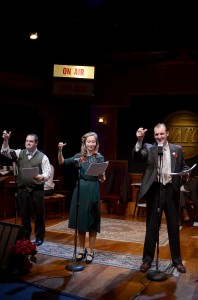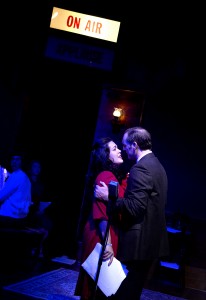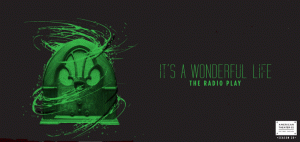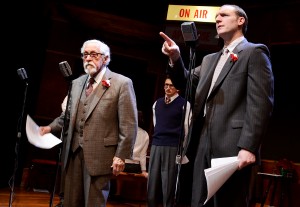IT’S STILL WONDERFUL
In just a few seasons, It’s a Wonderful Life: The Radio Play has ascended to the top of the Christmas tree of essential local holiday entertainments. A show that could be corny and sappy turns out to be a triumph of warmth, humor, and nostalgia.
There are two versions of It’s a Wonderful Life playing on the city’s north side, one at the American Theater Company and the other at the American Blues Theater. Both have been worth seeing in the past, but I chose the ATC version this season because it features Mike Nussbaum, who I would follow anywhere.
 It’s a Wonderful Life, as everyone must know, started out as a 1946 motion picture directed by Frank Capra that has assumed iconic status in American pop culture. A few years ago, someone got the idea that the film would be an effective stage piece adapted into a 1940’s radio broadcast. Multiple versions of this concept exist, all based on a recreation of a radio show with the theater audience serving as the radio studio audience.
It’s a Wonderful Life, as everyone must know, started out as a 1946 motion picture directed by Frank Capra that has assumed iconic status in American pop culture. A few years ago, someone got the idea that the film would be an effective stage piece adapted into a 1940’s radio broadcast. Multiple versions of this concept exist, all based on a recreation of a radio show with the theater audience serving as the radio studio audience.
The movie tells the story of George Bailey, an ambitious young man who yearns to leave small-town Bedford Falls to make his mark in the world as an architect. George’s father runs the town’s building and loan society, a bulwark of integrity against the greed of the villainous Mr. Potter, who wants to take over Bedford Falls and turn it into a slum for his financial advantage. George’s father suddenly dies and George is thrust into the man’s position as head of the building and loan, squashing his hopes for college and travel.
 George stays in Bedford Falls and marries. Then a crisis at the savings and loan threatens to ruin George’s life and in despair, he contemplates suicide, figuring that with his life insurance policy, he is worth more dead than alive to his family. Enter the story’s fantasy element. Heaven has its eye on George, and Clarence, an apprentice angel, is sent down to earth to show George how much of a difference he has made in the lives of people around him. It all ends happily, and the success of Clarence’s mission finally earns him a coveted set of wings.
George stays in Bedford Falls and marries. Then a crisis at the savings and loan threatens to ruin George’s life and in despair, he contemplates suicide, figuring that with his life insurance policy, he is worth more dead than alive to his family. Enter the story’s fantasy element. Heaven has its eye on George, and Clarence, an apprentice angel, is sent down to earth to show George how much of a difference he has made in the lives of people around him. It all ends happily, and the success of Clarence’s mission finally earns him a coveted set of wings.
The stage adaptation takes place in a radio studio in Chicago. A company of eight performers takes on the many roles in the story, exploiting the contrivances of radio drama, including a sound effects man who operates at one side of the stage. An applause sign flashes periodically to cue the audience when to clap. Commercials from actual businesses in the theater’s neighborhood are injected and messages are collected from the audience and read by the actors. It’s unlikely many people in the live audience ever saw the inside of a radio studio, but the ATC studio environment seems just right.
I’ve seen the radio play a half dozen times and each time I am struck by how successfully such an artificial concept immerses the audience in the show. The spectator may begin the evening with a feeling of amused tolerance at the radio concept, but it doesn’t take long for the impact of the narrative to take hold. It will be a cold-hearted viewer who doesn’t choke up a little at the end when George realizes he’s led a meaningful life after all.
The story is a grabber but the success of the show is also a testament to the power of the radio play, now a vanished art form confined to rebroadcasts on old time radio programs. The show demonstrates that we don’t need a lot of spectacle to sell a Christmas story. The human voice and a solid script suffice. The performers on the ATC stage do a bit of physical acting, but mostly they stand in front of the microphone and let their talking carry the evening. The actors change characters with simple alternations of vocal inflection. Mike Nussbaum shifts from the lovable Clarence to the evil Mr. Potter in a nanosecond, and the viewer buys into the transformation just as though two separate actors were performing the roles.
Cliff Chamberlain plays George Bailey with a persuasive intensity, really making George’s suicidal desperation come alive. Along with Nussbaum, the supporting cast is a marvel of versatility in their instant and multiple shifts of voices and personalities. They are Tony Lawry, Sadieh Rifai, Tyler Ravelson, Jessie Fisher, and Chris Amos, with Rick Kubes providing the sound effects and the delightfully named Rhapsody Snyder the mood-setting piano accompanist.
Tom Burch designed the credible studio set and Elsa Hiltner is responsible for the bull’s-eye 1940’s costume designs. Amanda Sager is the sound designer. The production is directed with unobtrusive sensitivity by Jason Gerace.
What I most admire about the production is its respect for the original story and the radio presentation. The sentimentality doesn’t gush and the nostalgia doesn’t spill over into a smug tolerance. Plus the ticket price is a small fraction of the cost for most pageant-laden productions that populate the holiday scene.
photos by Katie Sikora
It’s a Wonderful Life: The Radio Play
American Theater Company
ends on December 30, 2012
[on March 4, 2018, American Theater Company ceased operations; more on this story at Chicago Tribune]



{ 1 comment… read it below or add one }
Please keep me up-to-date with this year’s (2015) production.